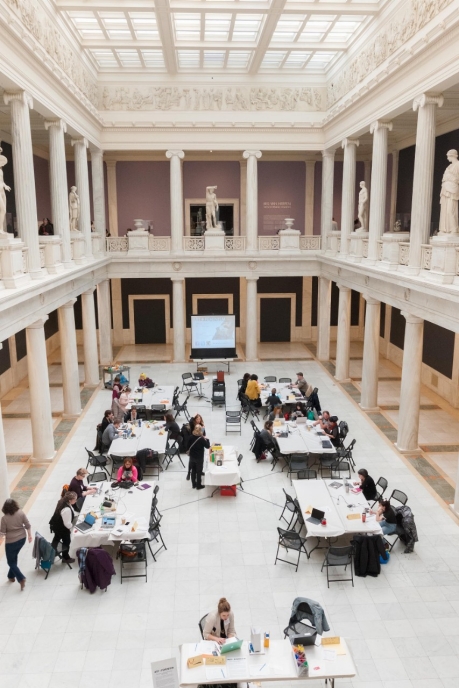Librarians Who Wikipedia: Mary Phillips, Carnegie Library of Pittsburgh
Wikipedia + Libraries: Better Together is an OCLC project that is building bridges between public libraries and Wikipedia; featuring an online training program for US public library staff hosted by WebJunction in the fall of 2017. Librarians Who Wikipedia is a series of interviews with library staff who engage with Wikipedia.

The 2017 Art+Feminism editing event at the Carnegie Museum of Art’s Hall of Sculpture. Mary
Phillips, a reference librarian at the Carnegie Library has collaborated with nearby libraries and
institutions to organize public Art+Feminism editing events. Photo credit: Bryan Conley ©
Carnegie Museum of Art, Pittsburgh
Meet Mary Phillips, a reference librarian at Carnegie Library of Pittsburgh. Phillips edits Wikipedia when she sees a missing reference. She also collaborates with nearby museums and universities to co-organize Art+Feminism editing events, a global outreach initiative to improve Wikipedia articles on feminism and the arts.
How did you get involved with the Art+Feminism editing events?
I am a reference librarian with the Carnegie Library of Pittsburgh, a public library. We have a couple of unique collections. We’ve been working on improving access by reaching out to the many nearby libraries and academic institutions. I got in touch with academic art librarians and I found about the Art+Feminism editing events. I said yes, yes to Wikipedia outreach around art and feminism. I’m interested in art collections management, and I’m equally interested in digital and media literacy in this changing information ecology. Librarians, especially public librarians, are uniquely positioned to engage with this interface. Wikipedia is powerful; librarians can make it more reliable.
What is it like to host events?
They were very successful. There were two events in 2016; I helped at the one University of Pittsburgh organized in collaboration with the Carnegie Museum of Art, Carnegie Mellon University and the Frick Fine Arts Library at the University of Pittsburgh. We had 80 people. We received research requests, we did on-the-spot training, I assisted with technology—we crashed the Wi-Fi!
This year we collaborated again and held the event at the Carnegie Museum of Art, in a big marble room with sculptures. We had about 30 attendees. In addition, people wandered in and asked what’s going on. “We’re editing Wikipedia!” we said.
In 2016, I was the lone public librarian at the event. This year, a colleague joined me, and we plugged our databases and collections. We’re a public library, we serve everyone, but I got a lot of, “Oh I didn’t know you could do that at the public library!” By doing these events, we built bridges between institutions.
What editing have you done?
You know, there should be a word for the rabbit hole you go down when you start poking around [in Wikipedia]! If I find myself in one of those spirals, I’ll just check the citations. Yep, it’s a very reference librarian thing [to do]. I like citations; that’s my nerd card. I’m not going to create new pages; I’ll help with finding reliable sources of information. I match my skillset to improve the quality of this resource; I’m a librarian on Wikipedia.
What message do you want to share with public libraries?
Librarians are really important to Wikipedia. We’re experts in recognizing authority. And we are experts in how people interact with information that is mediated. We are uniquely positioned to help this resource become the best it can be.
We shouldn’t be afraid of it—Wikipedia is not going to replace us. Public library staff should learn more about editing Wikipedia; then we could do more together.
You can incorporate Wikipedia into your public library’s programming. Learn more in our article on Extending the Reach of Public Libraries.
